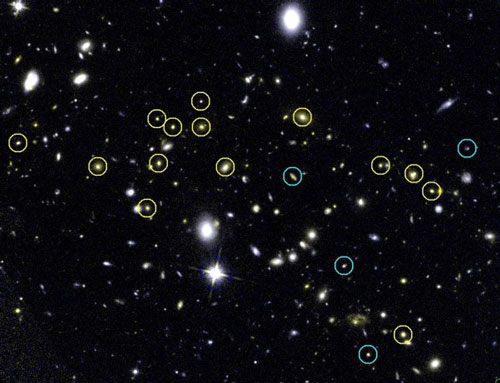| May 22, 2014 |
Very distant galaxy cluster confirmed
|
|
(Nanowerk News) The structures and star populations of massive galaxies appear to change as they age, but much about how these galaxies formed and evolved remains mysterious. Many of the oldest and most massive galaxies reside in clusters, enormous structures where numerous galaxies are found concentrated together. Galaxy clusters in the early universe are thought to be key to understanding the lifecycles of old galaxies, but to date astronomers have located only a handful of these rare, distant structures.
|
|
New research from a team led by Carnegie's Andrew Newman has confirmed the presence of an unusually distant galaxy cluster, JKCS 041. It is published by the Astrophysical Journal ("Spectroscopic Confirmation of the Rich z = 1.80 Galaxy Cluster JKCS 041 using the WFC3 Grism: Environmental Trends in the Ages and Structure of Quiescent Galaxies").
|
 |
| Hubble Space Telescope image of the center of the newly-confirmed JKCS 041 galaxy cluster, located at a distance of 9.9 billion light years. The galaxies located in the cluster are circled. Blue circles show the few galaxies that continue to form new stars, while yellow circles show those that have already entered quiescence.
|
|
"Our observations make this galaxy cluster one of the best-studied structures from the early universe," Newman said.
|
|
Although the team began studying JKCS 041 in 2006, it has taken years of observing with many of the world's most powerful telescopes to finally confirm its distance. The team used the Hubble Space Telescope to capture sharp images of the distant cluster and split the starlight from the galaxies into its constituent colors, a technique known as spectroscopy. They found 19 galaxies at precisely the same great distance of 9.9 billion light years, the tell-tale sign of an early galaxy cluster.
|
|
A previous study using the Chandra X-ray Observatory discovered X-ray emissions in the location of JKCS 041.
|
|
"These X-rays likely originate from hot gas in JKCS 041, which has been heated to a temperature of about 80 million degrees by the gravity of the massive cluster," said team member Stefano Andreon of the Osservatorio Astronomico di Brera, who led a companion paper published by Astronomy & Astrophysics, which is available here.
|
|
Today the largest and oldest galaxies are found in clusters, but there is a mystery about when and why these giant galaxies stopped forming new stars and became dormant, or quiescent. Peering back to a time when the galaxies in JKCS 041 were only 1 billion years old---or 10 percent of their present age---the team found that most had already entered their quiescent phase.
|
|
"Because JKCS 041 is the most-distant known cluster of its size, it gives us a unique opportunity to study these old galaxies in detail and better understand their origins," Newman said.
|
|
Once massive galaxies enter their quiescent phase, they continue expanding in overall size. This is thought to occur as galaxies collide with one another and evolve into a new, larger galaxy. Early clusters are suspected to be prime locations for these collisions, but to the team's surprise they found that the galaxies in JKCS 041 were growing at nearly the same rate as non-cluster galaxies.
|

